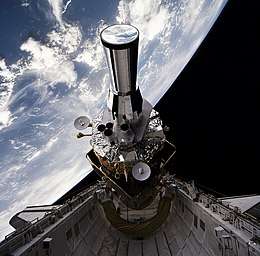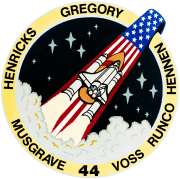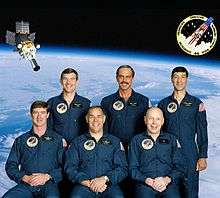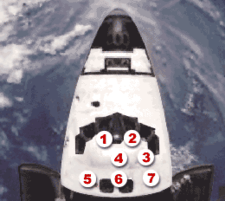STS-44
STS-44 was a Space Shuttle mission using Atlantis that launched on 24 November 1991. It was a U.S. Department of Defense space mission.
 Atlantis deploys a DSP satellite. | |
| Mission type | Satellite deployment |
|---|---|
| Operator | NASA |
| COSPAR ID | 1991-080A |
| SATCAT no. | 21795 |
| Mission duration | 6 days, 22 hours, 50 minutes, 44 seconds |
| Distance travelled | 4,651,112 kilometers (2,890,067 mi) |
| Orbits completed | 110 |
| Spacecraft properties | |
| Spacecraft | Space Shuttle Atlantis |
| Launch mass | 117,766 kilograms (259,630 lb) |
| Landing mass | 87,919 kilograms (193,828 lb) |
| Payload mass | 20,240 kilograms (44,620 lb) |
| Crew | |
| Crew size | 6 |
| Members |
|
| Start of mission | |
| Launch date | 24 November 1991, 23:44:00 UTC |
| Launch site | Kennedy LC-39A |
| End of mission | |
| Landing date | 1 December 1991, 22:34:12 UTC |
| Landing site | Edwards Runway 5 |
| Orbital parameters | |
| Reference system | Geocentric |
| Regime | Low Earth |
| Perigee altitude | 363 kilometers (226 mi) |
| Apogee altitude | 371 kilometers (231 mi) |
| Inclination | 28.5° |
| Period | 91.9 minutes |
  Left to right - Seated: Hendricks, Gregory, Musgrave; Standing: Voss, Hennen, Runco | |
Crew
| Position | Astronaut | |
|---|---|---|
| Commander | Frederick D. Gregory Third and last spaceflight | |
| Pilot | Terence T. Henricks First spaceflight | |
| Mission Specialist 1 | James S. Voss First spaceflight | |
| Mission Specialist 2 | F. Story Musgrave Fourth spaceflight | |
| Mission Specialist 3 | Mario Runco, Jr. First spaceflight | |
| Payload Specialist 1 | Thomas J. Hennen Only spaceflight | |
Crew seating arrangements
| Seat[1] | Launch | Landing |  Seats 1–4 are on the Flight Deck. Seats 5–7 are on the Middeck. |
|---|---|---|---|
| S1 | Gregory | Gregory | |
| S2 | Henricks | Henricks | |
| S3 | Voss | Runco | |
| S4 | Musgrave | Musgrave | |
| S5 | Runco | Voss | |
| S6 | Hennen | Hennen | |
Mission highlights
The launch was on 24 November 1991 at 23:44:00 UTC. A launch set for 19 November was delayed due to replacement and testing of a malfunctioning redundant inertial measurement unit on the Inertial Upper Stage booster attached to the Defense Support Program satellite. The launch was reset for 24 November and was delayed by 13 minutes to allow an orbiting spacecraft to pass and to allow external tank liquid oxygen replenishment after minor repairs to a valve in the liquid oxygen replenishment system in the mobile launcher platform. Launch weight was 117,766 kilograms (259,630 lb).
The mission was dedicated to the Department of Defense. The unclassified payload included a Defense Support Program (DSP) satellite and attached Inertial Upper Stage (IUS), deployed on flight day one. Cargo bay and middeck payloads included the Interim Operational Contamination Monitor (IOCM), Terra Scout, Military Man in Space (M88-1), Air Force Maui Optical System (AMOS), Cosmic Radiation Effects and Activation Monitor (CREAM), Shuttle Activation Monitor (SAM), Radiation Monitoring Equipment III (RME III), Visual Function Tester-1 (VFT-1), Ultraviolet Plume Instrument (UVPI), Bioreactor Flow, Particle Trajectory experiment, and Extended Duration Orbiter Medical Project, a series of investigations in support of Extended Duration Orbiter.
The landing was on 1 December 1991 at 22:34:44 UTC, Runway 5, Edwards Air Force Base, California. The rollout distance was 11,191 feet (3,411 m), and the rollout time was 107 seconds. The landing weight was 193,825 pounds (87,918 kg). The landing was originally scheduled for Kennedy Space Center on 4 December, but the ten-day mission was shortened and the landing rescheduled following the 30 November on-orbit failure of one of three orbiter inertial measurement units. The lengthy rollout was due to minimal braking for test. Atlantis returned to Kennedy on 8 December. This was also the final shuttle landing on a dry lake bed runway.
Wake-up calls
NASA began its longstanding tradition of waking up astronauts with music during Apollo 15. Each track is specially chosen, often by the astronauts' families, and usually has a special meaning to an individual member of the crew, or is applicable to their daily activities.
| Day | Song | Artist | Played/For |
|---|---|---|---|
| Day 2 | Recorded message from Patrick Stewart | Mario Runco | |
| Day 3 | This is the Army, Mr Jones | Irving Berlin | |
| Day 4 | It's Time to Love (Put a little love in your heart) | James Brown | |
| Day 5 | Cheesburger in Paradise | Jimmy Buffett | |
| Day 6 | Twist and Shout from Ferris Bueller's Day Off | ||
| Day 7 | University of Alabama and Auburn University fight songs | Jim Voss and Jan Davis | |
| Day 8 | In the Mood |
See also
References
- "STS-44". Spacefacts. Retrieved 26 February 2014.
External links
![]()
.jpg)